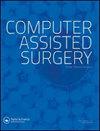基于主动机器人系统的TKA切削面尺寸精度研究
IF 1.9
4区 医学
Q3 SURGERY
引用次数: 2
摘要
摘要对机器人TKA中骨切割面尺寸精度进行了研究。一名外科医生对四具尸体的膝盖进行了机器人TKA。开发了一种测量股骨和胫骨切面尺寸精度的新技术。CT扫描用于创建术前计划,并在3D骨模型上生成标称切面。TKA后,对切割表面进行激光扫描。两个股骨组成部分也被扫描并与标称尺寸进行比较。平面度计算为每个切割面与最佳拟合平面之间的标准差。将五个股骨最佳拟合平面之间的角度与标称值进行比较。计算股骨切面与标称切面之间的点对点距离,以估计骨与种植体之间的间隙。切割表面的平均平整度为0.16±0.06 mm,不同切割平面之间的变化较小。股骨切面的平均角度误差为0.47±0.39°,与假体的误差幅度相似。97.9%表面的骨与种植体间隙平均在±1mm以内。使用一种新颖的方法,发现主动机器人系统的TKA尺寸精度对于股骨和胫骨切割都非常高。需要与其他机器人系统以及人工和机器人技术进行比较研究。本文章由计算机程序翻译,如有差异,请以英文原文为准。
Dimensional accuracy of TKA cut surfaces with an active robotic system
Abstract This is a study of the dimensional accuracy of the bone cut surfaces in robotic TKA. One surgeon performed robotic TKA on four cadaveric knees. A novel technique was developed for measuring the dimensional accuracy of both the femoral and tibial cut surfaces. CT scans were used to create a pre-operative plan and generate nominal cut surfaces on the 3D bone model. After TKA, the cut surfaces were then laser scanned. Two femoral components were also scanned and compared to nominal dimensions. Flatness was computed as the standard deviation between each of the cut surfaces and the best-fit plane. The angles between the five femoral best-fit planes were compared to the nominal values. The point-to-point distances between the femoral cut surfaces and the nominal cut planes were computed to estimate the bone-to-implant gap. The cut surfaces had an average flatness of 0.16 ± 0.06 mm with low variability between different cut planes. The femoral cut surfaces had average angular errors of 0.47 ± 0.39°, which are of similar magnitude as the errors found for the implants. The bone-to-implant gap was within ±1 mm for 97.9% of the surface on average. Using a novel methodology, the dimensional accuracy of an active robotic system for TKA was found to be very high for both the femoral and tibial bone cuts. Comparison studies are needed with other robotic systems as well as studies comparing manual and robotic techniques.
求助全文
通过发布文献求助,成功后即可免费获取论文全文。
去求助
来源期刊

Computer Assisted Surgery
Medicine-Surgery
CiteScore
2.30
自引率
0.00%
发文量
13
审稿时长
10 weeks
期刊介绍:
omputer Assisted Surgery aims to improve patient care by advancing the utilization of computers during treatment; to evaluate the benefits and risks associated with the integration of advanced digital technologies into surgical practice; to disseminate clinical and basic research relevant to stereotactic surgery, minimal access surgery, endoscopy, and surgical robotics; to encourage interdisciplinary collaboration between engineers and physicians in developing new concepts and applications; to educate clinicians about the principles and techniques of computer assisted surgery and therapeutics; and to serve the international scientific community as a medium for the transfer of new information relating to theory, research, and practice in biomedical imaging and the surgical specialties.
The scope of Computer Assisted Surgery encompasses all fields within surgery, as well as biomedical imaging and instrumentation, and digital technology employed as an adjunct to imaging in diagnosis, therapeutics, and surgery. Topics featured include frameless as well as conventional stereotactic procedures, surgery guided by intraoperative ultrasound or magnetic resonance imaging, image guided focused irradiation, robotic surgery, and any therapeutic interventions performed with the use of digital imaging technology.
 求助内容:
求助内容: 应助结果提醒方式:
应助结果提醒方式:


